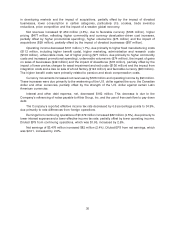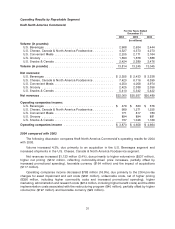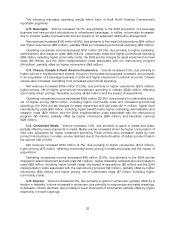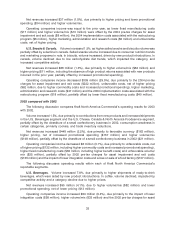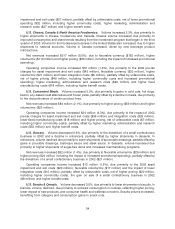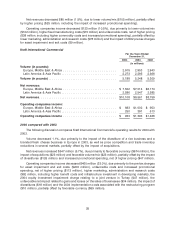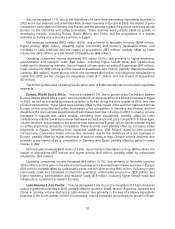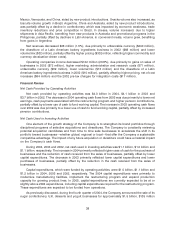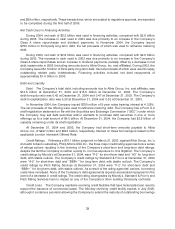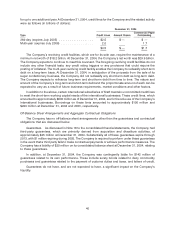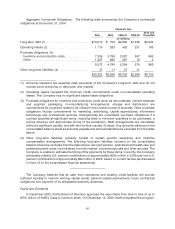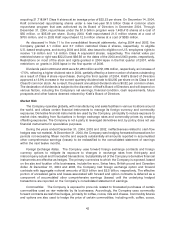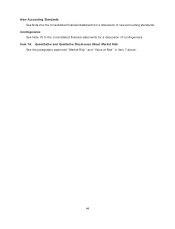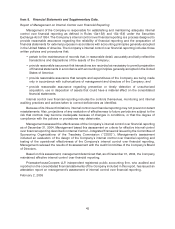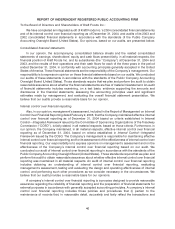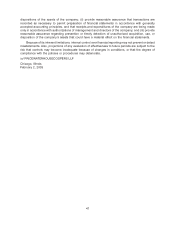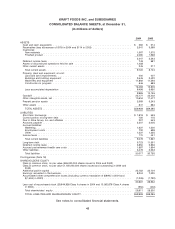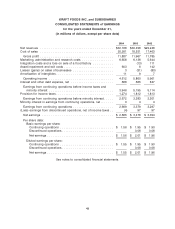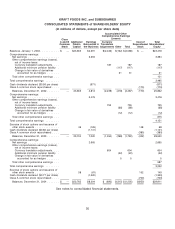Kraft 2004 Annual Report Download - page 41
Download and view the complete annual report
Please find page 41 of the 2004 Kraft annual report below. You can navigate through the pages in the report by either clicking on the pages listed below, or by using the keyword search tool below to find specific information within the annual report.
for up to one additional year. At December 31, 2004, credit lines for the Company and the related activity
were as follows (in billions of dollars):
December 31, 2004
Commercial Paper
Type Credit Lines Amount Drawn Outstanding
364-day (expires July 2005) ................... $2.5 $— $—
Multi-year (expires July 2006) .................. 2.0 1.7
$4.5 $ — $1.7
The Company’s revolving credit facilities, which are for its sole use, require the maintenance of a
minimum net worth of $18.2 billion. At December 31, 2004, the Company’s net worth was $29.9 billion.
The Company expects to continue to meet this covenant. The foregoing revolving credit facilities do not
include any other financial tests, any credit rating triggers or any provisions that could require the
posting of collateral. The multi-year revolving credit facility enables the Company to reclassify short-term
debt on a long-term basis. At December 31, 2004, in anticipation of the proceeds from the sale of its
sugar confectionery business, the Company did not reclassify any short-term debt as long-term debt.
The Company expects to refinance long-term and short-term debt from time to time. The nature and
amount of the Company’s long-term and short-term debt and the proportionate amount of each can be
expected to vary as a result of future business requirements, market conditions and other factors.
In addition to the above, certain international subsidiaries of Kraft maintain uncommitted credit lines
to meet the short-term working capital needs of the international businesses. These credit lines, which
amounted to approximately $600 million as of December 31, 2004, are for the sole use of the Company’s
international businesses. Borrowings on these lines amounted to approximately $150 million and
$220 million at December 31, 2004 and 2003, respectively.
Off-Balance Sheet Arrangements and Aggregate Contractual Obligations
The Company has no off-balance sheet arrangements other than the guarantees and contractual
obligations that are discussed below.
Guarantees. As discussed in Note 18 to the consolidated financial statements, the Company had
third-party guarantees, which are primarily derived from acquisition and divestiture activities, of
approximately $25 million at December 31, 2004. Substantially all of these guarantees expire through
2013, with $1 million expiring during 2005. The Company is required to perform under these guarantees
in the event that a third party fails to make contractual payments or achieve performance measures. The
Company has a liability of $20 million on its consolidated balance sheet at December 31, 2004, relating
to these guarantees.
In addition, at December 31, 2004, the Company was contingently liable for $142 million of
guarantees related to its own performance. These include surety bonds related to dairy commodity
purchases and guarantees related to the payment of customs duties and taxes, and letters of credit.
Guarantees do not have, and are not expected to have, a significant impact on the Company’s
liquidity.
40


